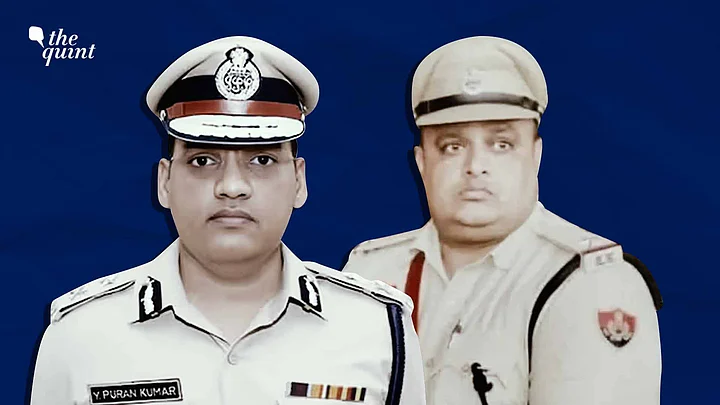IPS officer Y Puran Kumar's alleged suicide, followed by the death of Assistant Sub-Inspector (ASI) Sandeep Lathar a week later, have shaken the Haryana Police and exposed deep issues within India’s policing system.
On 7 October, Kumar allegedly died by suicide in Chandigarh, leaving behind a note accusing several senior officers of caste discrimination, public humiliation, and mental harassment. His death followed a transfer to a police training college and the detention of his personal security officer.
Immediately after his death, an FIR was registered for abetment of suicide and also under provisions of the Scheduled Castes and the Scheduled Tribes (Prevention of Atrocities) Act, 1989; Dalit organisations held demonstrations demanding justice; and political parties exchanged accusations.
The state government responded by transferring the Rohtak Superintendent of Police and sending Haryana’s Director General of Police (DGP) on leave.
A week later, another officer, Sandeep Lathar, allegedly died by suicide near Rohtak. In a video and a four-page note, Lathar accused Kumar of corruption, alleging that officers from his own caste were given favourable postings, and that women personnel were sexually exploited with promises of transfers.
The Cracks Beneath the Uniform
Beyond the tragedy, these deaths reflect the structural failures that continue to plague Indian policing: politicisation and corruption, the absence of oversight, and the persistence of casteism.
As appears to be unfolding in Haryana, transfers, inquiries and postings, instead of serving administrative needs, often become instruments of pressure or favour, revealing how deeply political influence, lack of transparency, and institutional weakness are intertwined.
Allegations of caste discrimination add another layer of concern, exposing how casteism continues to shape the functioning of one of the state’s most powerful institutions. In all of this, a crisis of credibility has emerged in the very institution meant to uphold justice. Addressing these failures demands the long-overdue police reforms be carried out, that alone can restore public trust in law enforcement.
Politicisation and Corruption
Both the deaths in Haryana point to a system where the lives of police personnel, their service conditions, and perhaps by extension, their interactions with the citizens at large, are shaped less by administrative logic, rules or merit, but by patronage and political influence.
This is precisely the issue the Supreme Court sought to address in Prakash Singh v Union of India (2006). The court’s directives regarding fixed tenures for key posts, establishment of boards to decide transfers, and separation of investigation from law-and-order functions, were meant to insulate police personnel from political and internal pressure. Nearly two decades later, we still continue to face the exact same issues, and reforms remain largely on paper.
The problem, however, is older and deeper. Almost five decades ago, the National Police Commission’s third report (1980) acknowledged the scope for corruption in the day-to-day working of the police, citing extortion of money by threat, bribery at the stage of recruitment, periodic payments from shopkeepers, and fabrication of false evidence during investigations.
The Justice Srikrishna Commission (1993) reached a similar conclusion. It observed,
“The canker of corruption has eaten into the entrails of Indian society, and the police department is no exception. If at all the canker is very much openly in evidence here.”
It further stressed that “frequent transfers of police personnel on grounds other than administrative convenience, and nepotism and corruption in the matter of posting, allotment of quarters and even grant of leave, have haunted the police administration for long. Political interference at all levels has aggravated the problem.”
Even then, the structures that enable this remain unchanged. The Haryana crisis simply exposes, once again, the same entrenched patterns that were identified decades ago—a system where discretion and influence operate with little oversight or consequence.
Caste Lines Within the Force
Caste and communal bias within the police, as well as the underrepresentation of marginalised communities within its ranks, have been flagged on multiple occasions before. The Haryana episode has only brought these long-standing concerns about the institution’s composition and internal culture back into focus.
The serious allegations of humiliation, caste-based discrimination, and exclusion that surfaced after Kumar’s death are now under investigation. These claims will have to withstand judicial scrutiny under the SC/ST Act. But they also face the complexity of this case, with allegations having been made against senior police officers, and in view of the counter-allegations by ASI Lathar, who has accused Kumar of caste-based favouritism. As the inquiry unfolds, it must navigate not only these issues but also the realities of India’s justice system, where, according to the National Crime Record Bureau (NCRB)’s 2023 data, pendency of cases under the Act stands at 94 percent.
Irrespective of the outcome, the events unfolding reveal how deeply caste continues to shape the functioning of the police even today.
The twin deaths in Haryana are symptoms of a larger institutional problem.
We may hope that Kumar's and Lathar’s deaths yield a single truth, but for now, together, they reveal an institution in distress. The task ahead is not merely to assign blame but to confront, with honesty and urgency, the structures that made it possible.
(Naveed Mehmood Ahmad is Lead and Senior Resident Fellow, Crime & Punishment at Vidhi Centre for Legal Policy. Views are personal. This is an opinion piece. All views expressed are the author’s own. The Quint neither endorses nor is responsible for them.)
